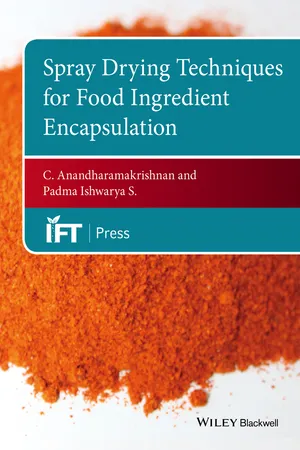
Spray Drying Techniques for Food Ingredient Encapsulation
- English
- ePUB (mobile friendly)
- Available on iOS & Android
Spray Drying Techniques for Food Ingredient Encapsulation
About this book
Spray drying is a well-established method for transforming liquid materials into dry powder form. Widely used in the food and pharmaceutical industries, this technology produces high quality powders with low moisture content, resulting in a wide range of shelf stable food and other biologically significant products. Encapsulation technology for bioactive compounds has gained momentum in the last few decades and a series of valuable food compounds, namely flavours, carotenoids and microbial cells have been successfully encapsulated using spray drying.
Spray Drying Technique for Food Ingredient Encapsulation provides an insight into the engineering aspects of the spray drying process in relation to the encapsulation of food ingredients, choice of wall materials, and an overview of the various food ingredients encapsulated using spray drying. The book also throws light upon the recent advancements in the field of encapsulation by spray drying, i.e., nanospray dryers for production of nanocapsules and computational fluid dynamics (CFD) modeling.
Addressing the basics of the technology and its applications, the book will be a reference for scientists, engineers and product developers in the industry.
Frequently asked questions
- Essential is ideal for learners and professionals who enjoy exploring a wide range of subjects. Access the Essential Library with 800,000+ trusted titles and best-sellers across business, personal growth, and the humanities. Includes unlimited reading time and Standard Read Aloud voice.
- Complete: Perfect for advanced learners and researchers needing full, unrestricted access. Unlock 1.4M+ books across hundreds of subjects, including academic and specialized titles. The Complete Plan also includes advanced features like Premium Read Aloud and Research Assistant.
Please note we cannot support devices running on iOS 13 and Android 7 or earlier. Learn more about using the app.
Information
1
Introduction to spray drying
1.1 INTRODUCTION
“The process of simultaneously atomizing and desiccating fluid and solid substances, and its application to the purpose of the exhaustion of moisture from such substances, and for the prevention of destructive chemical change.”Samuel R. Percy (1872)
- Atomization of the feed solution.
- Contact of spray with the hot gas.
- Evaporation of moisture.
- Particle separation.

1.2 STAGE 1: ATOMIZATION
1.2.1 Principle of atomization
Table of contents
- Cover
- Title Page
- Table of Contents
- About the authors
- Preface
- Acknowledgments
- 1 Introduction to spray drying
- 2 Introduction to encapsulation of food ingredients
- 3 Spray drying for encapsulation
- 4 Selection of wall material for encapsulation by spray drying
- 5 Encapsulation of probiotics by spray drying
- 6 Encapsulation of flavorsand specialty oils
- 7 Encapsulation of bioactive ingredients by spray drying
- 8 Spray drying for nanoencapsulation of food components
- 9 Functional properties of spray dried encapsulates
- 10 Analysis of spray dried encapsulates
- 11 Modeling approach for spray drying and encapsulation applications
- 12 Synergistic spray drying techniques for encapsulation
- 13 Industrial relevance and commercial applications of spray dried active food encapsulates
- Index
- Advert Page
- End User License Agreement